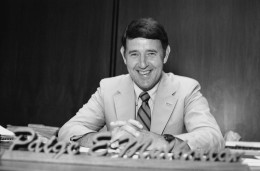
Paige Mulhollan is remembered on campus as a dynamic but “laid-back” president who took time to personally interact with faculty, staff and students.
Former Wright State University president, Paige E. Mulhollan, who established Wright State as a founding member of the Coalition of Urban and Metropolitan Universities, died Saturday in Fayetteville, Arkansas, at the age of 77.
“President Mulhollan was a visionary. He recognized the importance of research excellence and community service as integral to the academic experience of our students,” said President David R. Hopkins. “Paige ushered in the full university experience for our students with his focus on the Student Union, campus housing and the Wright State University Nutter Center. We are forever indebted to him. And our hearts go out to his wife, Mary Bess and his sons, Paige, Jr. and Kelly.”
During his presidency from 1985 to 1994, the College of Science and Engineering split to form the College of Engineering and Computer Science, and the College of Science and Mathematics; the Center for Teaching and Learning opened to assist faculty development in teaching; and Wright State athletics moved to NCAA Division I. In 1990, the university hosted the first national conference of metropolitan universities and launched the journal for member institutions.
Community support for Wright State under President Mulhollan’s leadership continued to expand in the early 1990s. Research funding topped $20 million in 1991–92. In 1992, the Kellogg Foundation announced a $2 million grant to fund the Partners for Community Health Development Project. This was designed to improve health care delivery and develop innovative ways to train health care professionals in medicine, nursing and psychology.
His years marked an expansion of facilities and programs that enhance student and academic life: on-campus housing increased to nearly 2,000 students; the Ervin J. Nutter Center and the Fritz and Dolores Russ Engineering Center were built; and construction began on a new Student Union. When the Nutter Center was built, he was successful in making the facility much larger than the original plan for a building originally conceived as just a basketball arena. He literally doubled the size to make in the multi-use facility it is today.
Dr. Mulhollan is remembered on campus as a dynamic but “laid-back” president who took time to personally interact with faculty, staff and students. He was fond of sailing. During his presidency, he could often be found taking lunchtime jogs around campus or exercising his golden retrievers, Sunshine and Autumn, on the lawn of Rockafield House, then the campus president’s residence, with his wife, Mary Bess.
“A university is a very complex organization,” he once said. “If you commit yourself to one point of view, you are not going to be able to serve all sectors of the community. I feel it’s important to be flexible and tolerant, adapting yourself and your attitudes to circumstances as they come up.”
President Mulhollan came to Wright State with a strong background in higher education administration. He was executive vice president at Arizona State University, where he also served as chief operations officer for Arizona State West, ASU’s Phoenix branch campus. Prior to being named ASU executive vice president in 1981, he served as ASU provost and vice president for academic affairs.
He earlier served as dean of arts and sciences and professor of history at the University of Oklahoma. Prior to that, he was associate dean of arts and sciences and associate professor of history at Kansas State University. From 1968 to 1969, he was a special research associate with the University of Texas Oral History Project in Washington, D.C. He also served as a faculty member at the University of Arkansas from 1963 to 1970.
He was active in educational associations, the fine arts and the humanities. He served as consultant-examiner for the North Central Education Association, consultant for the Education Programs Division of the National Endowment for the Humanities, chair of the Oklahoma Humanities Committee and member of the Commission on Fine Arts. He was a founding member of the executive committee of the Division of Urban Affairs of the National Association of State Universities and Land-Grant Colleges and served on a similar committee in the American Association of State Colleges and Universities.
Dr. Mulhollan earned his bachelor’s degree in marketing and his master’s degree in history from the University of Arkansas. He earned his doctorate in history from the University of Texas
In a 1986 article in the Wright State University student newspaper, he said, “I think that one of the biggest mistakes people make in looking at someone’s career is to assume they have taken a long-term look at where they were going. I got into administration entirely by accident . . . I never had a timetable for where I would be at different points in my career. If you do your job and pay attention to what you’re supposed to be accomplishing, opportunities will come, and the future will take care of itself.”
In retirement, Paige and Mary Bess lived in Arkansas. He is survived by his wife, Mary Bess, his sons Paige Jr. and Kelly, three grandchildren and a great-grandchild.

 Milling around
Milling around  Wright State recognizes Nursing Professor Kim Ringo for advancing international student success
Wright State recognizes Nursing Professor Kim Ringo for advancing international student success  Wright State honors graduating students for distinguished doctoral dissertations
Wright State honors graduating students for distinguished doctoral dissertations  Top 10 Newsroom videos of 2025
Top 10 Newsroom videos of 2025  Museum-quality replica of historic Hawthorn Hill donated to Wright State
Museum-quality replica of historic Hawthorn Hill donated to Wright State 